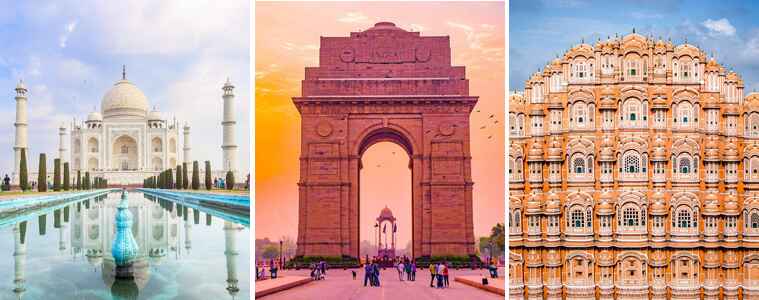Agra Fort, also known as the Red Fort Agra or Agra Kila, is a UNESCO World Heritage Site and one of the most iconic Monuments Built by Mughals. This majestic fort stands as a testament to the architectural brilliance and historical significance of the Mughal Empire. In this blog, we will delve into its history, architecture, and other essential details.
History of Agra Fort
The origins of Agra Fort can be traced back to the 11th century when it was initially constructed as a modest brick fort by the Chauhan Dynasty. Over the centuries, it underwent significant transformations, culminating in its grand redesign by the Mughal Emperor Akbar in the 16th century. However, it gained prominence during the Mughal era, particularly under Emperor Akbar, who rebuilt it with red sandstone in 1573. The fort served as the main residence of the Mughal emperors until the capital shifted to Delhi, and it became an essential part of the empire’s strategic defense system. The fort also housed important court functions, including military and political decisions that shaped the empire’s direction.
It witnessed significant historical events, including the imprisonment of Emperor Shah Jahan by his son Aurangzeb, who confined his father in a room with a view of the Taj Mahal, the monument Shah Jahan had built in memory of his wife Mumtaz Mahal. Agra Fort played a pivotal role in the Mughal dynasty’s legacy and remains a symbol of their grandeur. Known as the “Red Fort Agra” due to its distinctive red sandstone walls, it was not only a royal residence but also a fortified military base that ensured the safety and stability of the empire. The fort’s architecture, with its majestic gates, towers, and intricate carvings, continues to attract visitors from around the world, standing as a testament to the might and opulence of the Mughal era.
Places to Visit Inside Agra Kila Or Agra Fort
Agra Fort houses several fascinating structures that reflect the grandeur of Mughal Architecture. Some of the must-visit places inside the fort include:
Jahangir Mahal
A palace built by Akbar for his son Jahangir, this structure showcases a blend of Hindu and Central Asian architectural styles. The intricately carved arches, large courtyards, and delicate jharokhas (overhanging enclosed balcony) create a majestic and serene atmosphere. The Mahal’s grand entrance and its decorative elements reflect the royal taste and the cultural amalgamation of the Mughal empire at the time.
Diwan-i-Aam
Known as the Hall of Public Audience, this area was used by the emperor to address public grievances and conduct official meetings. The open and airy space, flanked by rows of columns, allowed for a large number of courtiers and common people to gather. The design of the hall emphasizes the accessibility and fairness of the emperor’s rule, where people could directly voice their concerns.
Diwan-i-Khas
The Hall of Private Audience was reserved for high-ranking officials and foreign dignitaries. Its intricate carvings and marble inlays are a sight to behold. The hall features an impressive central throne, where the emperor would sit under a canopy, often engaging in confidential matters. The finely detailed decorations and the use of precious stones illustrate the Mughal affinity for luxury and refinement.
Musamman Burj
This octagonal tower, built by Shah Jahan, offers stunning views of the Taj Mahal. It is also where Shah Jahan spent his last days in captivity. The tower is a blend of both functional and aesthetic design, featuring large windows and beautiful inlay work. Despite being a place of confinement, the Musamman Burj provides a poignant glimpse into the emperor’s longing for the Taj Mahal, which he had built in memory of his beloved wife Mumtaz Mahal.
Moti Masjid
Known as the Pearl Mosque, this white marble mosque exudes serenity and elegance. Its simplicity and grandeur combined make it a masterpiece of Mughal architecture. The mosque is a peaceful retreat, characterized by its gentle curves and delicate proportions, and it stands in stark contrast to the opulent palaces around it. The pristine white marble and intricate lattice work evoke a sense of purity and tranquility, making it a must-visit for admirers of Mughal religious architecture.

Agra Fort Architecture
The Red Fort Agra architecture is a blend of Islamic and Hindu styles, showcasing the creativity and craftsmanship of the Mughal era. Built primarily with red sandstone, the fort covers an area of approximately 94 acres and has a semi-circular layout
Key Features
Massive Walls: The fort is surrounded by 70-foot-high walls that provide an imposing appearance.
Magnificent Gates: There are four main gates, with the Amar Singh Gate serving as the primary entrance today.
Intricate Designs: The interiors are adorned with floral motifs, calligraphy, and geometric patterns.
Marble Structures: Later additions by Shah Jahan, such as the Diwan-i-Khas and Musamman Burj, incorporate white marble, enhancing the fort’s aesthetic appeal.
You May Also Read: Akbar Tomb Sikandra / Taj Mahotsav 2025 Dharohar
Agra Fort Timings and Entry Fees
Please note that these fees are inclusive of charges from the Archaeological Survey of India (ASI) and the Agra Development Authority (ADA). It’s advisable to carry a valid ID during your visit.
Agra Fort Timings: Agra Fort Timings are 6:00 AM to 6:00 PM and open every day. It is advisable to visit early in the morning or late in the afternoon to avoid crowds and enjoy a pleasant experience.
Agra Fort Entry Fees: The Agra Fort Entry Fees is quite reasonable. The general entry fee is INR 40 for Indian nationals and INR 600 for foreign tourists. SAARC and BIMSTEC citizens: INR 90 per person and below 15 years old can enter without any entry fee.
| Citizenship | Entry Fee |
| Indian Citizens | INR 340 |
| Foreign Nationals | INR 600 |
| SAARC/BIMSTEC Nations | INR 90 |
| Children (Below 15) | Free Entry |
Best Time to Visit Agra Fort
The best time to visit Agra Fort is during the winter months (October to March) when the weather is pleasant. Avoid visiting during peak summer (April to June) as the temperatures can soar, making it uncomfortable to explore the fort.
How to Reach Agra Fort
Agra Fort is well-connected by various modes of transportation:
Air: The nearest airport is Agra Airport, located about 13 km from the fort.
Train: Agra Fort has its own railway station, and Agra Cantonment Railway Station is just 5 km away, making it easily accessible.
Road: Agra is well-connected to major cities via highways. You can hire a taxi, take a bus, or drive to the fort. The fort is located near popular attractions such as the Taj Mahal and Akbar Tomb Sikandra.
Conclusion
Agra Fort, also known as the Red Fort Agra, is a magnificent symbol of the Mughal Empire’s legacy. Its rich history, stunning architecture, and strategic importance make it a must-visit destination for history enthusiasts and tourists alike. Whether you’re exploring the monuments built by Mughals or admiring the intricate designs, it offers an unforgettable experience. Explore the grandeur of Agra Fort and immerse yourself in the rich history and architecture of this Mughal masterpiece. Don’t miss the chance to witness its timeless beauty and book a tour of agra with The Imperial Tours to explore various places of the city.
FAQs
Q. Are Agra Fort and Red Fort the same?
Ans. No, Agra Fort and Red Fort are not the same. Akbar built Agra Fort in Agra, while Shah Jahan constructed the Red Fort in Delhi. Both forts, however, share similarities in architectural style and historical significance.
Q. Who built the Agra Fort?
Ans. The Chauhan dynasty originally built it as a brick fort, and Mughal Emperor Akbar reconstructed and expanded it in the 16th century.
Q. What is the architectural style of Agra Fort?
Ans. This fort showcases a blend of Islamic and Hindu architectural styles, featuring red sandstone structures with intricate carvings and marble inlays.
Q. What are the key attractions within Agra Fort?
Ans. Key attractions include Jahangir Mahal, Diwan-i-Aam, Diwan-i-Khas, Musamman Burj, and the Moti Masjid.
Q. Is Agra Fort a UNESCO World Heritage Site?
Ans. Yes, it was declared as a World Heritage Site in 1983 by UNESCO.
Q. What is the significance of Musamman Burj in Agra Fort?
Ans. Musamman Burj is an octagonal tower where Shah Jahan was imprisoned by Aurangzeb. There are stunning views of the Taj Mahal.








